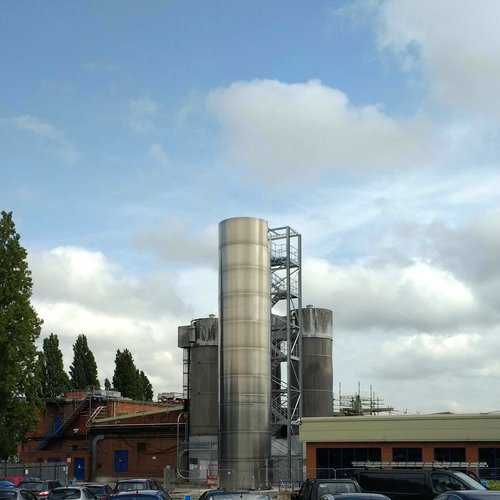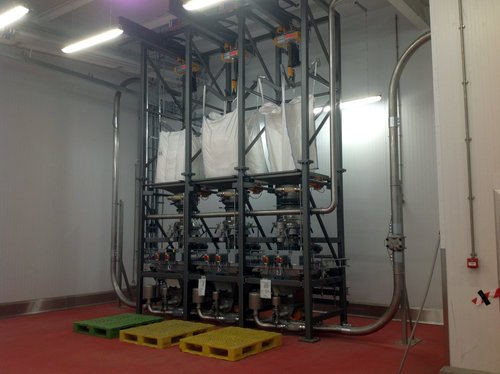Protecting Workers' Health: The Call for Powder Handling Automation in Food Manufacturing
Urgency to Embrace Powder Handling Automation
The food industry is constantly evolving, and companies that recognise the importance of worker safety and well-being are leading the way. However, protecting workers from the risks of powder exposure has always been a challenging task. Often, traditional solutions to these risks are not practical or cost-effective. Fortunately, with the advent of robotics and automation, a solution is now available.
Manual powder handling processes such as scooping, pouring, and weighing have been an integral part of the industry for decades. However, these processes put workers at risk of respiratory problems, lung damage, and cancer caused by exposure to hazardous powders. By investing in powder handling automation, companies can reduce the risk of exposure and ensure that their workers can work in a safe and healthy environment.
Beyond Respiratory Health: The Overlooked Impact of Dust Exposure in Food Manufacturing
The F&B manufacturing industry faces significant challenges when it comes to health and safety. According to HSE, respiratory diseases account for 12.5% of all occupational disease cases in the industry, with 12,000 new cases reported annually. In the food industry, occupational asthma accounts for 33% of compensation cases, with bakers being the second most affected group as reported by the Department of Work and Pensions Industrial Injuries Scheme. Dust from grain, flour, bakery dust, egg protein, fish protein, etc., are the primary culprits. These hazards can cause eye irritation, skin irritation, allergies, and other respiratory issues.
These symptoms can significantly impact a worker's quality of life and, in some cases, can even lead to long-term health problems.
Full automation is the solution. Automated systems, like those offered by OAL, significantly reduce workers' exposure to dust and other harmful particles, providing a safer and healthier workplace.
A Smart Investment: How Powder Handling Automation Can Boost Worker Health and Manufacturing Processes
Investing in powder handling automation not only protects workers' health but also brings several other benefits for both worker safety and manufacturing processes. Below are some of the key benefits of powder handling automation:
Benefits for Worker Health and Safety:
Reduced dust exposure - Automated powder handling systems eliminate the need for manual processes such as scooping, pouring, and weighing, significantly reducing workers' exposure to dust and other harmful particles that can put their health at risk.
Improved air quality - Advanced filtering systems in automated powder handling systems capture and eliminate any dust generated during the handling process, improving air quality, and reducing the risk of respiratory problems.
Safer workplace - With over 1,700 acute injuries reported every year, powder handling automation is a game-changer. By eliminating the risk of accidents and injuries associated with manual powder handling processes, automated systems provide a safer workplace, preventing back injuries and other occupational hazards.
Benefits for Manufacturers:
Increased efficiency - Automated systems ensure that the correct amount of powder is dispensed every time, eliminating the risk of over or under dosing, which can lead to product quality issues. Automated systems also have a higher throughput capacity, reducing production time and increasing efficiency.
Reduced waste - Automated powder handling systems accurately dispense the correct amount of powder, reducing waste and improving overall product quality.
Improved product quality and IP protection - Automated systems guarantee precise and consistent dosing, resulting in high-quality products that meet desired specifications and food compliance standards. By limiting access to the system, automation can also prevent unauthorised changes to the recipe, reducing the risk of errors and cross-contamination. This, in turn, enhances intellectual property (IP) protection by providing a reliable and traceable record of production.
Investing in powder handling automation is not only a smart business decision but also the best thing to ensure better efficiency and safety in operations. Protecting worker health and safety is a top priority for all organisations, and automated powder handling systems provide an effective solution for reducing dust exposure and improving overall workplace safety. The improved product quality provided by powder handling automation can also have a significant positive impact on a company's bottom line.
OAL's Innovative Solution for Doughnut Bakery: Protecting Workers' Health and Elevating Product Quality
Automated powder handling systems are a smart business investment. OAL's innovative solution for a doughnut bakery demonstrates how powder handling automation can significantly enhance worker health and safety while improving product quality. The system, which features three big bag stations with sifting, eliminates the incorrect batching of ingredients and minimises the loss of ingredients during transfer.
Image on left: The new silo designed and installed by OAL at the bakery
Image on right: Three Big Bag stations with Sifting
While small recipe additions are still made manually, the system's advanced features, such as an HMI and recipe management system, simplify monitoring of the production line and automate ingredient additions. This reduces the need for manual labour and minimises worker exposure to harmful particles.
Furthermore, commissioning and certification ensure that the system operates as required, and post-installation support is provided to ensure a smooth and efficient production process. The solution has enabled the doughnut production line to store and transport dry and liquid-based ingredients more efficiently, providing a safer and healthier working environment for bakery workers while ensuring high-quality products for consumers.
Explore the full case study here.
By embracing automation with APRIL, manufacturers can improve product quality and efficiency while addressing health and safety concerns for operators. With robots performing heavy lifting, musculoskeletal disorders can be avoided, and operators can be trained for more value-added roles such as controlling robots or maintaining equipment. The challenge will be to ensure that our workforce has the right skills to meet this future vision.
Building A Better World with Industry 5.0
Industry 5.0, the era of ‘Human-Tech Collaboration,’ merges the latest technological advances with human expertise to achieve the best of both worlds. By combining Industry 4.0's technological innovations with value-driven, human-centric initiatives, Industry 5.0 facilitates a seamless and collaborative interplay between people and machines, resulting in a high capacity, more sustainable, safe, and human-centric approach to food and beverage manufacturing.
The new industrial revolution will focus on celebrating workers and making technology work for them, not the other way around.
Discover more about how Industry 4.0 and 5.0 are transforming the future of food and beverage manufacturing and learn about the megatrends driving the shift towards the factory of the future in our exclusive report here.
The Responsibility of the Food Industry: Prioritising Workers' Health through Powder Handling Automation
The industrial revolution is entering a new era with Industry 5.0, where human and technology collaborate for a safer, sustainable, and equitable workplace. The food and beverage manufacturing industry is stepping up to this challenge by adopting robotics and automation for hazardous manual tasks like powder handling, weighing, and ingredient dosing. By embracing full automation, the industry not only reduces workers' exposure to harmful particles and dust but also improves efficiency, reduces waste, and enhances product quality. It is time for the industry to prioritise worker safety and take proactive measures towards Industry 5.0 for a better future.



